
Pinus flexilis, the limber pine, is a species of pine tree-the family Pinaceae that occurs in the mountains of the Western United States, Mexico, and Canada. It is also called Rocky Mountain white pine.
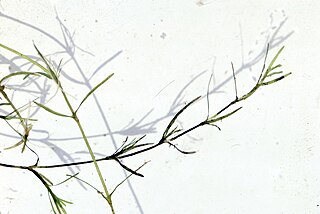
Najas flexilis is an aquatic annual plant native to parts of North America and Europe. It is native to northern and central Europe from Norway to Ireland to Switzerland, and from there across Russia. It is also considered native throughout most of Canada, and the northern United States in disjunct populations in southern California, Arizona, Missouri, South Carolina and Utah. Its common names include slender naiad and nodding waternymph.

Argyresthia is a genus of moths in the family Argyresthiidae, previously treated as subfamily Argyresthiinae in the family Yponomeutidae.
François-Xavier Bélanger was a French-Canadian naturalist and museum curator. An autodidact like many naturalists of the time, he specialized in the study of Microlepidoptera. Thanks to the influence of Léon Abel Provancher and Thomas-Étienne Hamel, he became curator of the zoology museum at Université Laval, where although he did a good job of enlarging the total collection, he did so in a generally poorly organized way. He was succeeded by his assistant curator Charles-Eusèbe Dionne.

Scythropia crataegella, the hawthorn moth, is a species of moth in the monotypic genus Scythropia. It is found in western Eurasia.
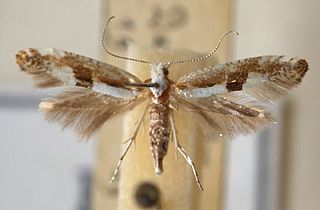
Argyresthia bonnetella is a moth of the family Yponomeutidae. It is found in Europe. The wingspan is 9–11 mm. The head is white. Forewings are shining ochreous-whitish, usually strigulated and sometimes discally suffused with ferruginous brown; a suffused ferruginous -brown median longitudinal streak from base to before middle; a curved dark ferruginous- brown fascia from middle of dorsum to 4/5 of costa, sometimes obsolete except on dorsum. Hindwings are grey. The larva is yellow-green; head and plate of 2 brown.

Argyresthia goedartella, the bronze alder moth, is a species of moth of the family Argyresthiidae.

Argyresthia pygmaeella is a moth of the family Yponomeutidae. The species was first described by Michael Denis and Ignaz Schiffermüller in 1775 from a specimen found near Vienna, Austria

Argyresthia spinosella is a moth of the family Yponomeutidae. It is found in Europe and Anatolia.
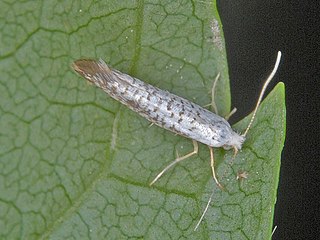
Argyresthia retinella is a species of moth of the family Yponomeutidae.
Argyresthia abies is a moth of the family Yponomeutidae first described by Hugh Avery Freeman in 1972. It is found in the Canadian provinces of Alberta, Saskatchewan and northern Ontario.

Argyresthia oreasella, the cherry shoot borer moth, is a moth of the family Yponomeutidae. It is found in North America, including New York, Michigan, Idaho, Missouri, Colorado, New Mexico, California, Quebec, Alberta and Saskatchewan.
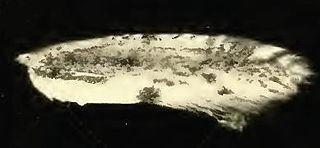
Argyresthia belangerella is a moth of the family Argyresthiidae first described by Vactor Tousey Chambers in 1877. It is found in Canada. It might be only a variety of Argyresthia conjugella.
Argyresthia calliphanes is a moth of the family Yponomeutidae first described by Edward Meyrick in 1913. It is found in Canada from Ontario to British Columbia and possibly in Alberta, Saskatchewan and Manitoba. In the United States, it ranges from New York to California.
Argyresthia columbia is a moth of the family Yponomeutidae first described by Thomas Nesbitt Freeman in 1972. It is found in Canada in south-eastern British Columbia and is possibly also present in Alberta.
Argyresthia laricella, the larch shoot moth, is a moth of the family Yponomeutidae. The species was first described by William D. Kearfott in 1908. It is found in Canada, including north-western Ontario, Nova Scotia, south-eastern Manitoba, Saskatchewan, western Alberta and southern British Columbia.
Argyresthia mariana, the graybanded leafroller, is a moth of the family Yponomeutidae. The species was first described by Thomas Nesbitt Freeman in 1972. It is found in Canada in northern Ontario and possibly Alberta.
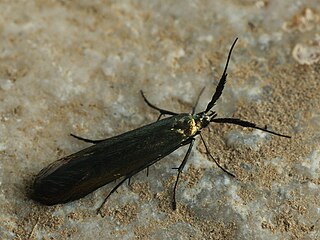
Friederike Lienig was an entomologist from the Russian Empire who also resided in the Kingdom of Prussia. Four species of tiny moths are named after her. One is Cosmopterix lienigiella. At first self taught she was later instructed by Philipp Christoph Zeller at the technical high school in Meseritz. She was a Member of the Stettin Entomological Society.
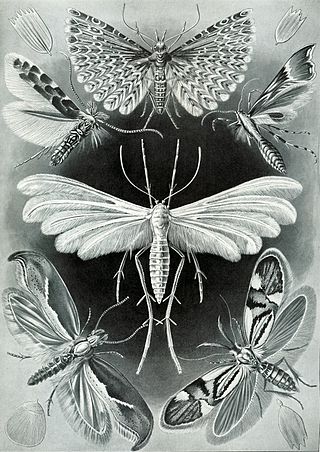
Annette Frances Braun was an American entomologist and leading authority on microlepidoptera, a grouping of mostly small and nocturnal moths. Her special interest was leaf miners: moths whose larvae live and feed from within a leaf.












